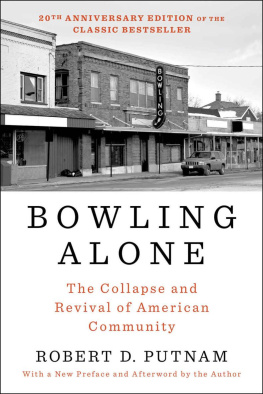
ALSO BY ROBERT D. PUTNAM
Making Democracy Work: Civic Traditions in Modern Italy
Double-Edged Diplomacy: International Bargaining and Domestic Politics (edited with Peter B. Evans and Harold K. Jacobson)
Hanging Together: The Seven-Power Summits
Bureaucrats and Politicians in Western Democracies
The Comparative Study of Political Elites
The Beliefs of Politicians: Ideology, Conflict, and Democracy in Britain and Italy
BOWLING ALONE
BOWLING ALONE
THE COLLAPSE AND REVIVAL OF AMERICAN COMMUNITY
Robert D. Putnam
SIMON & SCHUSTER
NEW YORK LONDON TORONTO SYDNEY SINGAPORE

SIMON & SCHUSTER
Rockefeller Center
1230 Avenue of the Americas
New York, NY 10020
www.SimonandSchuster.com
Copyright 2000 by Robert D. Putnam
All rights reserved, including the right of reproduction in whole or in part in any form.
SIMON & SCHUSTER and colophon are registered trademarks of Simon & Schuster, Inc.
Designed by Edith Fowler
Manufactured in the United States of America
10 9 8 7 6 5 4 3 2 1
Library of Congress Cataloging-in-Publication Data
Putnam, Robert D.
Bowling alone: the collapse and revival of American community / Robert D. Putnam.
p. cm.
Includes bibliographical references and index.
1. United StatesSocial conditions19452. Social changeUnited StatesHistory 20th century. I. Title.
HN65.P878 2000
3060973dc21 00-027278
ISBN 0-684-83283-6
ISBN 978-0-6848-3283-8
eISBN 978-0-7432-1903-7
The author and publisher gratefully acknowledge permission to reprint figure 95 from
Civic Engagement in American Democracy,
edited by Theda Skocpol and Morris P. Fiorina, The Brookings Institution Press, 1999.
Reprinted with permission of The Brookings Institution.
To Ruth Swank Putnam
and to the memory of Frank L. Putnam,
Louis Werner, and Zelda Wolock Werner,
exemplars of the long civic generation
Contents
SECTION ONE
Introduction
CHAPTER 1
Thinking about Social Change in America
NO ONE IS LEFT from the Glenn Valley, Pennsylvania, Bridge Club who can tell us precisely when or why the group broke up, even though its forty-odd members were still playing regularly as recently as 1990, just as they had done for more than half a century. The shock in the Little Rock, Arkansas, Sertoma club, however, is still painful: in the mid-1980s, nearly fifty people had attended the weekly luncheon to plan activities to help the hearing- and speech-impaired, but a decade later only seven regulars continued to show up.
The Roanoke, Virginia, chapter of the National Association for the Advancement of Colored People (NAACP) had been an active force for civil rights since 1918, but during the 1990s membership withered from about 2,500 to a few hundred. By November 1998 even a heated contest for president drew only fifty-seven voting members. Black city councillor Carroll Swain observed ruefully, Some people today are a wee bit complacent until something jumps up and bites them. VFW Post 2378 in Berwyn, Illinois, a blue-collar suburb of Chicago, was long a bustling home away from home for local veterans and a kind of working-class country club for the neighborhood, hosting wedding receptions and class reunions. By 1999, however, membership had so dwindled that it was a struggle just to pay taxes on the yellow brick post hall. Although numerous veterans of Vietnam and the post-Vietnam military lived in the area, Tom Kissell, national membership director for the VFW, observed, Kids today just arent joiners.
The Charity League of Dallas had met every Friday morning for fifty-seven years to sew, knit, and visit, but on April 30, 1999, they held their last Somehow in the last several decades of the twentieth century all these community groups and tens of thousands like them across America began to fade.
It wasnt so much that old members dropped outat least not any more rapidly than age and the accidents of life had always meant. But community organizations were no longer continuously revitalized, as they had been in the past, by freshets of new members. Organizational leaders were flummoxed. For years they assumed that their problem must have local roots or at least that it was peculiar to their organization, so they commissioned dozens of studies to recommend reforms. The slowdown was puzzling because for as long as anyone could remember, membership rolls and activity lists had lengthened steadily.
In the 1960s, in fact, community groups across America had seemed to stand on the threshold of a new era of expanded involvement. Except for the civic drought induced by the Great Depression, their activity had shot up year after year, cultivated by assiduous civic gardeners and watered by increasing affluence and education. Each annual report registered rising membership. Churches and synagogues were packed, as more Americans worshiped together than only a few decades earlier, perhaps more than ever in American history.
Moreover, Americans seemed to have time on their hands. A 1958 study under the auspices of the newly inaugurated Center for the Study of Leisure at the University of Chicago fretted that the most dangerous threat hanging over American society is the threat of leisure, a startling claim in the decade in which the Soviets got the bomb.Life magazine echoed the warning about the new challenge of free time: Americans now face a glut of leisure, ran a headline in February 1964. The task ahead: how to take life easy.
As a matter of fact, mankind now possesses for the first time the tools and knowledge to create whatever kind of world he wants. Despite our Protestant ethic, there are many signs that the message is beginning to
The civic-minded World War II generation was, as its own John F. Kennedy proclaimed at his inauguration, picking up the torch of leadership, not only in the nations highest office, but in cities and towns across the land. Summarizing dozens of studies, political scientist Robert E. Lane wrote in 1959 that the ratio of political activists to the general population, and even the ratio of male activists to the male population, has generally increased over the past fifty years. As the 1960s ended, sociologists Daniel Bell and Virginia Held reported that there is more participation than ever before in America and more opportunity for the active interested person to express his personal and political concerns.
By 1965 disrespect for public life, so endemic in our history, seemed to be waning. Gallup pollsters discovered that the number of Americans who would like to see their children go into politics as a lifes work had nearly doubled over little more than a decade. Although this gauge of esteem for politics stood at only 36 percent, it had never before been recorded so high, nor has it since. More strikingly, Americans felt increased confidence in their neighbors. The proportion that agreed that most people can be trusted, for example, rose from an already high 66 percent during and after World War II to a peak of 77 percent in 1964.
The fifties and sixties were hardly a golden age, especially for those Americans who were marginalized because of their race or gender or social class or sexual orientation. Segregation, by race legally and by gender socially, was the norm, and intolerance, though declining, was still disturbingly high. Environmental degradation had only just been exposed by Rachel Carson, and Betty Friedan had not yet deconstructed the feminine mystique. Grinding rural poverty had still to be discovered by the national media. Infant mortality, a standard measure of public health, stood at twenty-six per one thousand birthsforty-four per one thousand for black infantsin 1960, nearly four times worse than those indexes would be at the end of the century. America in
Next page






